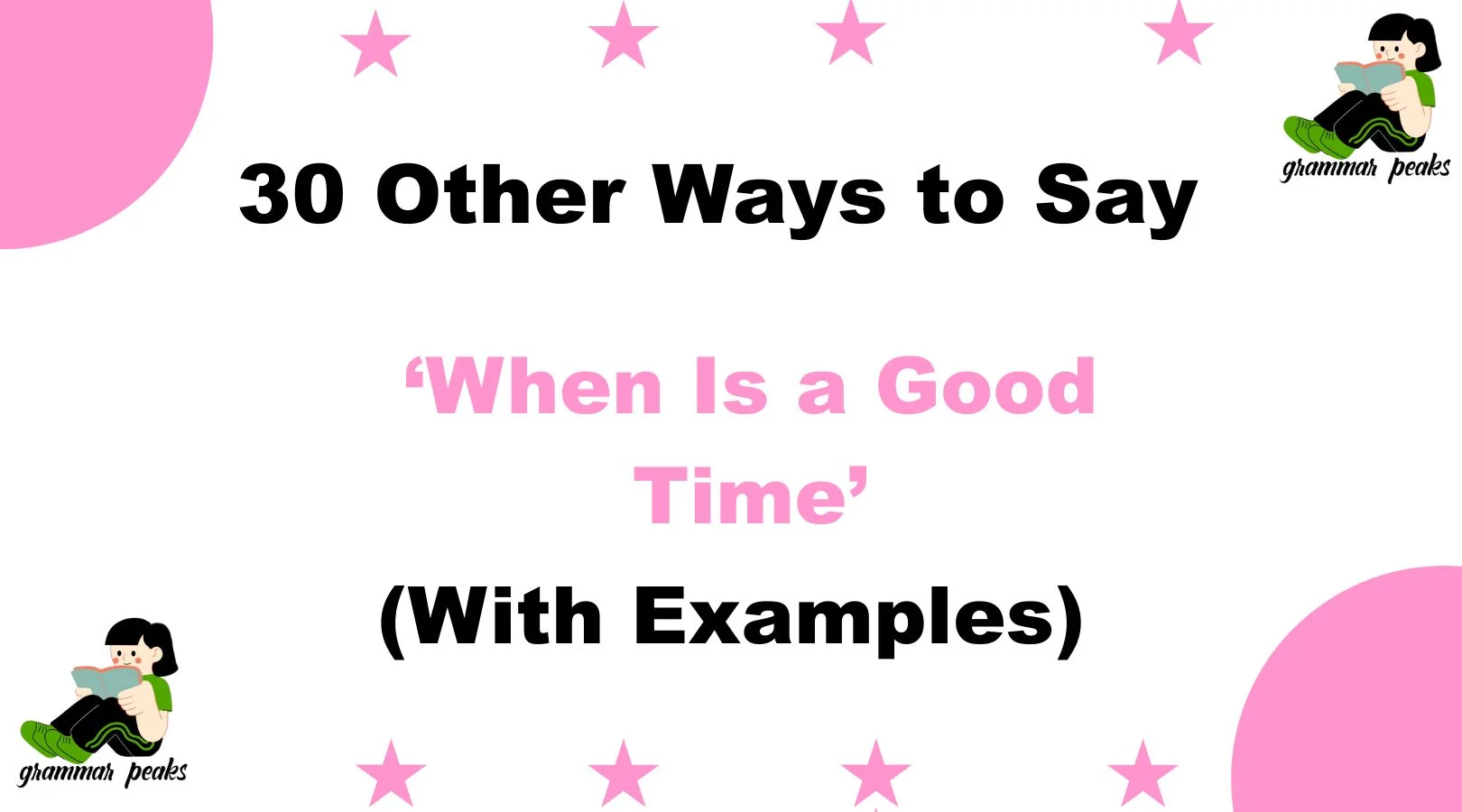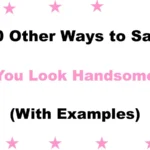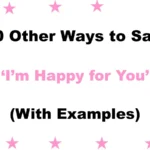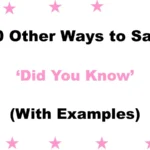Finding the right words to express yourself with warmth and care can truly transform a simple question into a thoughtful invitation. Asking “When is a good time?” is common, but using alternative phrases can make your message feel more personal, respectful, and meaningful.
Whether you’re scheduling a meeting, catching up with a friend, or arranging a call, choosing the perfect phrasing shows empathy and consideration for the other person’s time and feelings. In this article, you’ll discover 30 thoughtful alternatives to say “When is a good time?”—each with clear explanations and examples to help you communicate with greater care and professionalism.
What Does “When Is a Good Time” Mean?
“When is a good time?” is a polite way of asking someone to suggest a suitable moment for an appointment, conversation, or activity. It shows that you respect the other person’s schedule and want to find a mutually convenient moment. This phrase balances consideration and flexibility, allowing the other person to have control over timing.
When to Use “When Is a Good Time”
Use this phrase when you want to:
- Schedule a meeting or call
- Arrange a catch-up with friends or family
- Coordinate work-related tasks
- Politely ask for someone’s availability without pressure
It works well in both professional and casual contexts, making it versatile and widely accepted.
Is It Professional/Polite to Say “When Is a Good Time”?
Yes, it is both professional and polite. It conveys respect for the other person’s schedule and shows that you value their input. However, in very formal settings, you might prefer alternatives that sound slightly more polished or refined.
Pros and Cons of Saying “When Is a Good Time”
Pros:
- Polite and respectful
- Easy to understand
- Versatile for many contexts
Cons:
- Can sound routine or impersonal if overused
- Might lack warmth or personal touch in intimate conversations
Synonyms for “When Is a Good Time”
- When would be convenient for you?
- What time works best for you?
- When are you available?
- When can we meet?
- At what time should we connect?
- When does it suit you?
- When would you like to meet?
- When is a convenient time?
- What’s a good time for you?
- When would you prefer?
- When do you have time?
- When’s the best moment?
- When would it be best?
- When can we get together?
- When would you find it convenient?
- What time fits your schedule?
- When shall we meet?
- When would be a good moment for you?
- When do you think we could talk?
- When might you be free?
- What time is good for you?
- When can we catch up?
- When do you have a moment?
- When would you be open to meeting?
- When would be a suitable time?
- What’s your availability?
- When could we schedule?
- When would you be able to meet?
- When is a time that works?
- When do you want to get together?
1. When Would It Be Convenient for You?
Definition: A polite way to ask someone to choose a time that fits their schedule.
Detailed Explanation: This phrase puts the emphasis on the other person’s convenience, showing you value their comfort and availability.
Scenario Example: “I’d like to discuss the project. When would be convenient for you?”
Best Use: Professional settings or when you want to sound thoughtful and respectful.
Worst Use: Avoid if you want a quick or casual response—can sound formal.
Tone: Polite, considerate, professional.
2. What Time Works Best for You?
Definition: Asking which specific time suits the other person the most.
Detailed Explanation: This phrase is straightforward but still shows consideration for the other person’s preference.
Scenario Example: “Let’s set up a call. What time works best for you?”
Best Use: Professional or casual conversations when confirming availability.
Worst Use: May sound slightly transactional in very casual chats.
Tone: Friendly, clear, respectful.
3. When Are You Available?
Definition: A direct question about the person’s free time.
Detailed Explanation: This phrase is clear and efficient, often used in professional contexts.
Scenario Example: “We need to review the report. When are you available?”
Best Use: When you want a straightforward answer.
Worst Use: Can feel blunt if not softened with polite context.
Tone: Direct, professional, neutral.
4. When Can We Meet?
Definition: An invitation to decide a meeting time.
Detailed Explanation: This phrase focuses on arranging a meeting and assumes cooperation.
Scenario Example: “I’m free next week. When can we meet?”
Best Use: Scheduling meetings with colleagues or acquaintances.
Worst Use: Might feel pushy if overused without context.
Tone: Direct, cooperative.
5. At What Time Should We Connect?
Definition: Asking for a specific time to communicate or meet.
Detailed Explanation: This phrase is slightly formal and used often in business communications.
Scenario Example: “Regarding the update, at what time should we connect?”
Best Use: Formal meetings, calls, or video conferences.
Worst Use: Too formal for casual chats.
Tone: Professional, formal, courteous.
6. When Suits You?
Definition: A casual and concise way to ask about someone’s preferred time.
Detailed Explanation: Common in informal or semi-formal settings, showing flexibility.
Scenario Example: “We’re planning lunch. When does it suit you?”
Best Use: Casual meetings or friendly arrangements.
Worst Use: Not ideal for very formal situations.
Tone: Casual, friendly, flexible.
7. When Would You Like to Meet?
Definition: A polite question inviting the other person to choose a meeting time.
Detailed Explanation: This phrasing is considerate and leaves the choice fully to the other party.
Scenario Example: “We need to discuss your feedback. When would you like to meet?”
Best Use: Professional or personal invitations.
Worst Use: Avoid if you need to propose a time.
Tone: Polite, inviting, respectful.
8. When Is a Convenient Time?
Definition: A courteous way to ask for a suitable time.
Detailed Explanation: Emphasizes convenience, making the other person feel prioritized.
Scenario Example: “Can we schedule a call? When is a convenient time?”
Best Use: Professional communication with clients or colleagues.
Worst Use: May sound too formal for casual texts.
Tone: Polite, formal, considerate.
9. What’s a Good Time for You?
Definition: A friendly question to learn about someone’s preferred timing.
Detailed Explanation: This phrase is warm and approachable, suitable for many contexts.
Scenario Example: “I’d love to catch up! What’s a good time for you?”
Best Use: Casual and professional contexts.
Worst Use: None significant; very versatile.
Tone: Friendly, warm, inviting.
10. When Would You Prefer?
Definition: Asking about the other person’s preferred time.
Detailed Explanation: Shows respect for their choice and flexibility.
Scenario Example: “We’re planning the meeting. When would you prefer?”
Best Use: Formal and informal arrangements.
Worst Use: Can sound vague without context.
Tone: Respectful, flexible, polite.
11. When Do You Have Time?
Definition: A straightforward question about someone’s availability.
Detailed Explanation: This phrase is simple and effective. It respects the other person’s schedule while prompting a clear response.
Scenario Example: “I’d love to talk more about the proposal. When do you have time?”
Best Use: Great for both personal and professional contexts.
Worst Use: Can feel too direct if not accompanied by a warm tone.
Tone: Direct, respectful, flexible.
12. When’s the Best Moment?
Definition: A softer way of asking for the most suitable time.
Detailed Explanation: This phrase adds emotional warmth and can make the request feel more thoughtful.
Scenario Example: “I’d like to go over some ideas. When’s the best moment for you?”
Best Use: Great for meaningful conversations or emotionally sensitive topics.
Worst Use: Too vague for scheduling specific appointments.
Tone: Warm, thoughtful, caring.
13. When Would It Be Best?
Definition: A respectful and slightly formal question about timing.
Detailed Explanation: This phrase asks for the ideal time while placing importance on the other person’s comfort.
Scenario Example: “I have a few updates. When would it be best to discuss them?”
Best Use: Professional emails, thoughtful check-ins.
Worst Use: May feel too formal in quick texts.
Tone: Polite, formal, respectful.
14. When Can We Get Together?
Definition: A friendly and collaborative way to arrange a meet-up.
Detailed Explanation: Implies mutual interest in meeting while keeping the tone light.
Scenario Example: “It’s been a while! When can we get together?”
Best Use: Casual or semi-formal plans with friends, colleagues, or family.
Worst Use: Not ideal in very formal or corporate environments.
Tone: Friendly, upbeat, approachable.
15. When Would You Find It Convenient?
Definition: A very polite way to ask about the other person’s availability.
Detailed Explanation: Highlights their comfort and convenience as the top priority.
Scenario Example: “I’d appreciate your input. When would you find it convenient to chat?”
Best Use: Professional settings, especially with clients or senior colleagues.
Worst Use: Can sound overly formal in casual discussions.
Tone: Respectful, formal, customer-centric.
16. What Time Fits Your Schedule?
Definition: A considerate way of asking when someone is free.
Detailed Explanation: This phrase conveys flexibility and understanding of busy lives.
Scenario Example: “Let’s go over the plan. What time fits your schedule?”
Best Use: Useful for work meetings or setting appointments.
Worst Use: Can sound stiff if used in casual conversations.
Tone: Professional, flexible, courteous.
17. When Shall We Meet?
Definition: A slightly traditional way of asking about someone’s availability.
Detailed Explanation: Implies a decision will be made together, offering a sense of shared planning.
Scenario Example: “We’ve got some catching up to do—when shall we meet?”
Best Use: Great for semi-formal or friendly settings.
Worst Use: Might feel a bit old-fashioned in very modern, digital conversations.
Tone: Warm, polite, collaborative.
18. When Would Be a Good Moment for You?
Definition: A gentle and empathetic way of checking availability.
Detailed Explanation: This phrase communicates care and patience.
Scenario Example: “I need to go over a few changes. When would be a good moment for you?”
Best Use: Personal or emotionally sensitive topics.
Worst Use: May be too vague for highly scheduled environments.
Tone: Soft, caring, patient.
19. When Do You Think We Could Talk?
Definition: A respectful way to ask for a conversation.
Detailed Explanation: Adds a thoughtful layer by asking for their opinion on timing.
Scenario Example: “When do you think we could talk about your goals?”
Best Use: Coaching, mentoring, or supportive conversations.
Worst Use: Can feel uncertain if a decision is needed urgently.
Tone: Thoughtful, gentle, respectful.
20. When Might You Be Free?
Definition: A kind way of inquiring about someone’s availability.
Detailed Explanation: This phrase is informal but caring, making it perfect for low-pressure tasks.
Scenario Example: “I wanted to hear your thoughts. When might you be free?”
Best Use: Friendly chats or informal meetings.
Worst Use: Too casual for formal business emails.
Tone: Warm, relaxed, polite.
21. What Time Is Good for You?
Definition: A friendly and direct way of asking for a suitable time.
Detailed Explanation: Offers the other person control over choosing a time that works best for them.
Scenario Example: “We can chat tomorrow. What time is good for you?”
Best Use: Casual texts, work conversations, and social plans.
Worst Use: Slightly too casual for highly formal interactions.
Tone: Friendly, approachable, direct.
22. When Can We Catch Up?
Definition: A casual way to suggest reconnecting.
Detailed Explanation: Perfect for informal meetings or personal conversations.
Scenario Example: “It’s been ages! When can we catch up?”
Best Use: Friends, coworkers, or family.
Worst Use: Not suitable for corporate communications.
Tone: Playful, warm, personal.
23. When Do You Have a Moment?
Definition: A kind request for a brief conversation or update.
Detailed Explanation: Implies the conversation will be brief and that their time is respected.
Scenario Example: “When do you have a moment to discuss the edits?”
Best Use: Quick updates or casual work chats.
Worst Use: May feel too vague for detailed meetings.
Tone: Polite, light, respectful.
24. When Would You Be Open to Meeting?
Definition: A courteous and gentle way of proposing a meeting.
Detailed Explanation: Suggests flexibility and respect for personal boundaries.
Scenario Example: “I’d love to go over the proposal—when would you be open to meeting?”
Best Use: Great for client or prospect communications.
Worst Use: Can feel too tentative in time-sensitive discussions.
Tone: Respectful, open-ended, diplomatic.
25. When Would Be a Suitable Time?
Definition: A professional and polite way of asking for availability.
Detailed Explanation: Balances formality with respect, suitable for workplace settings.
Scenario Example: “Let’s schedule a review. When would be a suitable time?”
Best Use: Emails, business meetings, client relations.
Worst Use: Can sound too formal in personal settings.
Tone: Formal, professional, respectful.
26. What’s Your Availability?
Definition: Asking for a broader sense of someone’s schedule.
Detailed Explanation: Ideal for planning ahead or giving multiple options.
Scenario Example: “What’s your availability this week for a quick chat?”
Best Use: Project planning, scheduling interviews or calls.
Worst Use: Not personal enough for friendly invitations.
Tone: Efficient, professional, straightforward.
27. When Could We Schedule?
Definition: A question focused on locking in a time.
Detailed Explanation: Assumes the meeting will happen—now it’s just about choosing a time.
Scenario Example: “We need to go over your presentation—when could we schedule?”
Best Use: Confirming plans or follow-ups.
Worst Use: Too forward for initial outreach or casual chats.
Tone: Professional, assertive, clear.
28. When Would You Be Able to Meet?
Definition: A courteous way to ask about someone’s availability.
Detailed Explanation: Highlights the other person’s ability and willingness to meet.
Scenario Example: “When would you be able to meet to go over the campaign?”
Best Use: Formal emails, client meetings, or respectful follow-ups.
Worst Use: Slightly too formal for close friends.
Tone: Professional, considerate, polite.
29. When Is Time That Works?
Definition: A flexible way of checking someone’s schedule.
Detailed Explanation: Encourages the other person to choose a time that fits their needs.
Scenario Example: “We need to sync up. When is a time that works for you?”
Best Use: Project teams, collaborative environments.
Worst Use: Not ideal for very formal or rigid conversations.
Tone: Friendly, accommodating, efficient.
30. When Do You Want to Get Together?
Definition: A casual and inviting way of making plans.
Detailed Explanation: Emphasizes the other person’s preferences and makes the conversation feel open and friendly.
Scenario Example: “I miss our chats. When do you want to get together?”
Best Use: Friends, family, or relaxed team gatherings.
Worst Use: Not suitable for formal or structured business conversations.
Tone: Warm, informal, welcoming.
Conclusion
The phrase “When is a good time?” is useful—but with 30 heartfelt and polished alternatives at your fingertips, you can express care, professionalism, and emotional intelligence more effectively. Whether you’re writing a quick message, planning a meeting, or reaching out with warmth, choosing the right words shows respect, empathy, and emotional awareness. Thoughtful communication starts with thoughtful phrasing, and each of these alternatives helps you connect more meaningfully—with friends, colleagues, clients, or loved ones.
FAQs
1. What is a more professional way to say “When is a good time?”
A more professional alternative would be:
“When would be a convenient time to connect?”
This phrase shows respect for the recipient’s schedule and sounds polished in formal emails or business settings. Other professional options include “What time works best for you?” or “What’s your availability this week?”
2. Is “When is a good time?” considered polite in emails or texts?
Yes, it’s generally polite, but it can sound a bit generic or casual depending on context. If you’re emailing a manager, client, or someone unfamiliar, consider a warmer or more refined phrase like “When would you be available to discuss this further?” or “When might be a good time for you to talk?”
3. What’s the best phrase to use in sensitive conversations?
For emotional or sensitive topics, you want a phrase that conveys care and patience. A thoughtful option would be:
“When would be a good moment for you?”
Or even “Would now be a good time to talk?” if you’re unsure. These alternatives create space for the other person to respond comfortably.
4. How do I ask someone to talk without sounding pushy?
Use soft, open-ended phrases that invite rather than demand.
Try:
“When do you feel comfortable connecting?”
or
“Would there be a time that works well for you?”
These expressions show that you respect their time and emotional readiness.
5. Can I use these alternatives in text messages?
Absolutely! Many of the alternatives—such as “Got a minute?”, “When do you have time?”, or “When can we catch up?”—are perfect for texting. Just make sure your tone matches the context and your relationship with the person.






